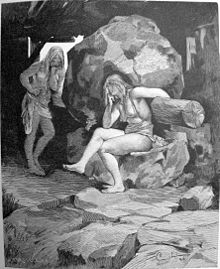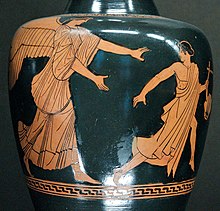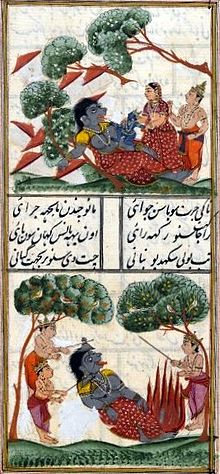Giantess (mythology)
A giantess is a female giant; either a mythological being, such as the Amazons in Greek mythology, or a woman of taller than average height, sometimes the result of a genetic or medical abnormality, such as gigantism.
Mythology
Greek Mythology
Giant women deserve a separate discussion from giant men for a number of reasons. For starters, while classical mythology contains many references to female giants, little information is given about them (this is in stark contrast to the detailed stories of male giants). The cause could be the patriarchal nature of these societies, which opposes the idea of empowering women.
Hindu mythology
In the Rig-veda (the oldest text in India, from the mid-2nd millennium BC) there is no mention of any female giant. Only in the legends about the god Krisná ―which are mentioned for the first time in the Majábharata (an epic-religious text from the 3rd century BC approximately)― does the story of a giant demon named Putana appear, that she gave baby Krisná to drink from her poisoned breast, but ended up killed by him.
According to the myth, at the request of the evil king Kamsa ―uncle of the newborn god Krisná― she poisoned her nipples to kill him and posed as an ordinary villager (of normal height). But Krisná sucked her milk and also her "vital air" from her (his prana , or spiritual energy from her). At that time she was unable to hide her original form: she re-assumed her stature of several hundred meters tall and with her fall she crushed an entire forest. As Krisná accepted her even though she was momentarily as a nurse, she reached the spiritual world, despite all her bad karma as a demon.
From this myth, Hindus extract two teachings: a) that if you serve God, even for a moment and with bad intentions, you destroy all karma (the reactions of good or bad activities). bad), and the results are optimal; and b) that women do not have the necessary moral strength to have power without being corrupted.
This legend was covered in several later Puranas, among which the Bhágavata-purana (approximately 10th century AD) presents the most detailed one.
Norse Mythology
In Viking society, women held a more prominent position, which was reflected in Norse mythology, where giantesses influenced the course of events and made demands.
Gríðr was a giantess who saved Thor's life. She was aware of Loki's plans to make Thor die at the hands of the giant Geirröd and she set out to help him by providing him with some magical gifts. These were: a powerful belt, a pair of magical iron gloves, and a magic wand.
The giantess Gerd was very beautiful and her shining bare arms lit up the air and the sea. Frey fell in love at first sight and the story of his courtship of her is recounted in the poem Skírnismál. Gerd never wanted to marry Freyr, she refused her proposals (sent through Skírnir, her messenger) even after receiving eleven golden apples and the Draupnir. Finally Skírnir threatened to use Freyr's sword to cover the land with ice and Gerd agreed to marry him. She would become the mother of the first Swedish Fjölnir kings.
Skaði traveled to Asgard to avenge her father Þjazi, who had been killed by the gods. She agreed to give up her claims if they allowed her to choose a husband from among them and if they could make her laugh. The gods allowed her to choose a husband, but she had to do it seeing only her feet; Skaði chose Njörðr because his feet were so beautiful that he thought he was Balder. Then Loki managed to make her laugh, thus achieving peace, and Odin made two stars with Þjazi's eyes. After a while they both separated, because she loved the mountains (Þrymheim), while he wanted to live near the sea (Nóatún). The saga of the Ynglings tells that Skaði later became the wife of Odin and had many children with him.
At Balder's funeral, his funeral ship was put into the sea by Hyrrokin, a giantess who came riding a wolf and gave the ship such momentum that fire shot from the rollers and the whole earth trembled.
Following Frigg's pleas, sent through the messenger Hermod, Hel promised to release Balder from the underworld if all objects animate or inanimate would weep for him. And they all did except one giantess, Thok, who refused to mourn the slain god. And so Balder had to remain in the underworld, from where he would not emerge until Ragnarök, when he and his brother Höðr had reconciled and ruled the new land together with the sons of Thor.
Literature
Medieval European Literature
A notable example of giantess depiction in art and literature arose in the medieval period. In her book Scivias, Saint Hildegard of Bingen (1098-1179) used a giantess as a representation of 'Ecclesia', the Church as the bride of Christ. Since Hildegarda is often considered a pioneer of the feminist movement, the appearance of the giantess as a symbol may not be a coincidence.
Modern European Literature
The giantess appears occasionally in more recent European literature. Charles Baudelaire, in his poetic cycle The Flowers of Evil (1861, written in French) presents the giant woman as a powerfully erotic symbol:
- Once, when Nature's overpowering vigorousness
- Conceived each day children this monstrous
- I would love to have lived with a young giantess
- Around her feet like a cat to a queen voluptuous.
- Would love to have seen the spirit that grew out of her
- Distending as she played her terrible game
- From the damp mist that swam in her eyes to wonder
- If her sullen heart would catch into flames.
In contrast to this, A Voyage to Brobdingnag (1726), the second part of Gulliver's Travels by Jonathan Swift (1667-1745) depicts the revulsion of the hero towards female forms enlarged to gigantic proportions. This approach to giantesses as an anti-erotic symbol persisted into the 20th century: C. S. Lewis recounts in his short story The Shoddy Lands a journey into the mind of a 'modern woman' # 3. 4;. Said woman is gigantic in size and therefore (from Lewis's point of view) repulsive: obsessed with her own beauty, she has become completely oblivious to the way in which beauty is perceived by her presumed admirers, that is, the men. Similarly, Arthur C. Clarke's story Cosmic Casanova describes an astronaut's disgust at the discovery that an alien woman he worshiped on a video screen is actually thirty feet tall.
Pop Culture
Comics
But the giantess motif isn't always anti-erotic. The growing popularity of female empowerment is reflected in the appearance of powerful female heroines in comics. Traditionally, female superheroes have been less well accepted than their male counterparts and have often been relegated to supporting roles (the major exception being Wonder Woman), appearing in no less than 1942).
This, however, has changed in recent decades, and powerful women have gained greater acceptance than ever before even among male readers. Heroines with size-changing powers have appeared in comics such as Doom Patrol, Team Youngblood, and Femforce. In later series, giant superheroines Tara Fremont and Garganta combine immense size and strength with beauty and femininity, and are cult-like among both men and women. Giantesses are even more common in Japan's manga/anime comics. The case of the series The 7 Deadly Sins (Nanatsu no taizai) one of the protagonists, Diana, is a young and friendly Giantess. In the Attack on Titan (Shingeki no Kyojin) manga, Annie Leonhardt's characters Ymir, Frieda Reiss, and Pieck Finger possessed the power to transform into the giants known as Titans. Being the first human being to obtain said power, a girl named Ymir Fritz.
Cinema
A few movies are also worth mentioning. The B-movie Attack of the 50-Foot Woman (1958) was one of a series of films devoted to size-shrinking, which also included The Incredible Shrinking Man. The 1993 remake of this film, starring Daryl Hannah as the giant woman, was promoted as a comedy. Many scenes did indeed parody the previous film (notably, The Amazing Colossal Man), although the central theme was feminism. The hero Nancy, once a zero to the left crushed by her domineering father and her husband, is empowered by her newfound size and begins to take control of her destiny, and encourages other women. to do the same. Both versions of are cult movies.
Erotic art and literature
The paraphilic fantasy of being crushed by giantesses is a frequently recorded sexual fantasy, which spawned a subgenre of pornography related to crushing. Other fantasies include normal-sized men having sex with, or simply being in the presence of, giant women. This type of fantasy is often referred to by the acronym GTS (contraction of giantess, «giantess» in English), although this term also covers situations in which the woman has a normal size and the man is reduced These fantasies can be classified as macrophilia, that is, sexual attraction towards giant beings (humans or animals). A large number of websites are devoted to this subgenre.
Literature
In the Harry Potter books, Rubeus Hagrid's mother is mentioned to be a giantess. Madame Maxime, Headmistress of the Beauxbatons School of Magic is described as a half-giant (Daughter of a Human and a Giant).
Contenido relacionado
Suzaku
Siegfried (character)
Nanahuatzin



